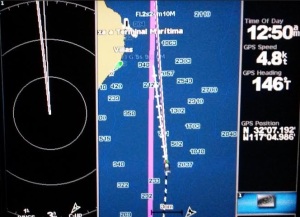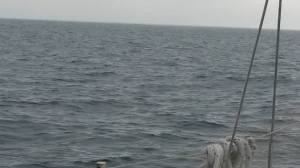Lots to talk about so I’ll break this up into a couple of posts.
Last week, we took Nakamal to Ensenada, MX. I called it a ‘scouting mission’ because we wanted to test a few things out.
- Getting the dinghy onboard for ocean sailing
- General cruising preparations
- Solo night watch
- Paperwork and process for checking in and out of Mexico
- Life in Mexico – eating, drinking, getting money, provisioning
- Home again
Here’s the first half of the adventure – getting ready to leave and traveling to Ensenada.
The Dinghy
This was a first for us. Yes, we have davits to hang the dinghy on, but in a rough sea there will be way too much stress on the davits and the dinghy to have it hanging there. The boat rocks, the dinghy does its pendulum impression, and eventually something will fray or crack.
So for short voyages maybe we’ll just move the engine to its resting place and tow the dinghy behind – that’s what we did when we went to Catalina Island before we had davits. On our Caribbean charters we left the engine on the dinghy with the prop lifted out of the water, but our longest voyage was 14 miles.
For longer passages aboard Nakamal the dinghy will get deflated and attached onto the forward deck. This will be trick when we are in an anchorage instead of at the dock in a marina, but like I keep saying: Many have gone before us and already figured it out. We will too.
General Cruising Preparations
From our several charters and Shakedown Cruise #1 (the trip to Catalina, from here on known as SC1), we had a good idea of what would shake, rattle, roll and spill all over the floor if we encountered rough seas. So we did a pretty good job of padding cupboard contents and packing up loose stuff.
For example I stuffed an oven mitt in the galley cupboard where the vinegar bottles are, and memorabilia that turns into small missiles if left loose on their shelf went into a bin.
And since it’s us, I had to think about food for the12-hour trip. We kept it simple – rotisserie chicken and deli coleslaw.
Plus the don’t-leave-home-without-them-must-have ‘passage cookies’. These are a peanut butter – oatmeal – banana – chocolate chip concoction
that make a great snack for those lonely night watches. This time I used the powdered peanut butter. Yes, powdered peanut butter. Who knew?
And, as a bonus, the marvelous Avi and his assistant installed the larger part of the bimini so we had shade on the trip. Yay! They’ll finish it up and make final adjustments this month.
Solo Night Watch
SC1 was from San Diego north to Catalina, which is just off the coast of Los Angeles. Meaning we had to cross a shipping lane. After dark we encountered our fair share of small craft, commercial fishing boats, cargo ships and tankers. We were with another couple; I partnered with our friend Bruce for the first watch, about 9 or 10 p.m. until 2 a.m. Bruce is experienced, calm and unflappable. He taught me a lot in those few hours.
At about 1 a.m. Bruce and I encountered a large vessel leaving the shipping lane without its AIS activated – meaning it didn’t show up on our chart plotter. Once we got their running lights figured out, a quick course adjustment and we missed them by a mile. The learning experience: no matter how reliable or modern your electronics, stick your frickin’ head outside the cockpit and LOOK AT THE OCEAN.
That lesson paid off on SC2. I was on second watch solo, scheduled from midnight to 4 a.m. After sleeping through the alarm then recharging myself with one of those yummy cookies and a cup of instant coffee, I was out there. Alone. In the dark. What a difference though – the chart plotter and radar was lit up like a Christmas tree on SC1; this journey not so much. It was quiet. Dark. Misty. Lonely.
Until about 2 a.m. Suddenly, out of the night mist – what’s that? A green light? With maybe a faint white light reflecting off the mist behind it? Luckily I stuck my frickin’ head out of the cockpit, because he didn’t have AIS (hence not on chart plotter) and was a tiny pinpoint on the radar. Seriously – he could have been an errant pixel in the display for all I knew. But because Bruce taught me to stick my head out and look around, he caught my attention until I could see his sail. Yes, another one of us, looking ghostly in the mist, probably also Ensenada bound and on course to potentially cross our path. It’s ironic that no matter how big the ocean, and how small the boats, we seem to find each other.
Once that situation resolved itself (I adjusted course, and he eventually slowed down) the next bit of excitement – up ahead – is that a blinking light, a star twinkling on the horizon or my imagination? Check the chart plotter, stick you head out. Count the blinks – are they always the same amount of time apart? Warning buoys are white lights, and flash the same number of seconds apart – 3, 4, 5, 6, 7 – whatever. Our chart plotter has these marked, and a little note with the number of seconds between flashes.
The blinking lights indicated land ahead, a small island that would have been big trouble if we continued on our course. Since it also marked our turn into the marina, and we were far ahead of schedule, I did the what a good first mate should do when there is a course question – I woke the captain a half hour early. He took over, we headed out to sea and cut the engine to float around and wait for daylight to make a clean entrance into the Marina Coral and our reserved berth.
In the next blog, read about the paperwork experience for getting in and out of Mexico with a boat, exploring Ensenada and the trip back to San Diego.









What a great adventure! I enjoy your posts!
LikeLike
Thanks Matt!
LikeLike
Many have gone before us and already figured it out. We will too.
Great quote…. ! Thanks!
LikeLike